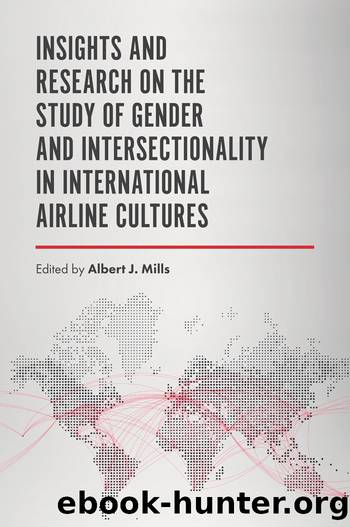Insights and Research on the Study of Gender and Intersectionality in International Airline Cultures by Mills Albert J.;

Author:Mills, Albert J.;
Language: eng
Format: epub
Publisher: Emerald Publishing Limited
Published: 2017-07-03T00:00:00+00:00
Masculine Hegemony and the Absence of Female Labor
Following First World War, a number of small commercial airlines began operation in the United Kingdom. Despite the fact that over 25,000 women had served in a range of capacities in the Womenâs Royal Air Force (WRAF) and tens of thousands of women had served in the aircraft construction industries during the war, less than a handful of women were employed in any of the new airline companies. Two women were employed in minor clerical roles in 1919â1920, both leaving upon marriage. A third woman was employed as a secretary in 1922; a widow, she went on to serve the airline for many years.
In 1937 when TCA was founded it was not unusual for women to be employed in the airline industry, albeit in a limited range of jobs. Nonetheless, the new airline was in operation for 14 months before it employed its first female employeesâtwo flight attendants or âstewardesses.â A third stewardess was employed later that year. These three women constituted less than 1% of the airlineâs 332 employees.
In both airlines the absence of women can be explained in large part by male dominance of the industry and gender notions that went far beyond the airlines at the respective points of time. Nonetheless, these explanations are circular and reductive; failing to explain how certain beliefs develop and get translated into action. As Connell (1995) has argued, we need to analyze relations of domination and subordination among different masculinities (Glenn, 1999: 28). Connell (1995) uses the term âhegemonic masculinityâ to describe âa particular idealized image of masculinity in relation to which images of femininity and other masculinities are marginalized and subordinatedâ (Barrett, 1996, p. 130).
At the 1919 predecessor airlines of BOAC, we find a dominance of wartime air force leaders and personnel coupled with a wartime ethos that was reproduced and reinforced through organizational symbolism and camaraderie. Within the airlines the owners were businessmen who had played important wartime roles in building and supplying military aircraft. They employed their senior and middle managers, chief pilots, and chief accountants from the ranks of the military officer class. Below them came the pilots and engineers who almost exclusively came from the ranks of the wartime air forces. Not unexpectedly many of the men knew each other, having served together in the war.
Within the airlines there was little to prevent the reproduction of wartime camaraderie and beliefs. Commercial aviation was a brand new industry that relied heavily on aviation experience and skills. In 1919 men with air force experience had a near monopoly on those skills, and thus, unsurprisingly, constituted the great majority of the workforce in commercial aviation. Drawing on Ackerâs (1992b) work on gendered processes, it is clear that the gendered division of labor owed much in the first place to wartime practices which excluded women from all but the WRAF, and even there they were excluded from combat and a range of associated roles. That this practice was reproduced is in large part
Download
This site does not store any files on its server. We only index and link to content provided by other sites. Please contact the content providers to delete copyright contents if any and email us, we'll remove relevant links or contents immediately.
The Brazilian Economy since the Great Financial Crisis of 20072008 by Philip Arestis Carolina Troncoso Baltar & Daniela Magalhães Prates(121367)
International Integration of the Brazilian Economy by Elias C. Grivoyannis(91289)
The Art of Coaching by Elena Aguilar(52949)
Flexible Working by Dale Gemma;(23254)
How to Stop Living Paycheck to Paycheck by Avery Breyer(19638)
The Acquirer's Multiple: How the Billionaire Contrarians of Deep Value Beat the Market by Tobias Carlisle(12241)
Thinking, Fast and Slow by Kahneman Daniel(12079)
The Radium Girls by Kate Moore(11921)
The Art of Thinking Clearly by Rolf Dobelli(10224)
Hit Refresh by Satya Nadella(9039)
The Compound Effect by Darren Hardy(8811)
Tools of Titans by Timothy Ferriss(8218)
Atomic Habits: Tiny Changes, Remarkable Results by James Clear(8186)
Turbulence by E. J. Noyes(7936)
A Court of Wings and Ruin by Sarah J. Maas(7652)
Change Your Questions, Change Your Life by Marilee Adams(7635)
Nudge - Improving Decisions about Health, Wealth, and Happiness by Thaler Sunstein(7616)
How to Be a Bawse: A Guide to Conquering Life by Lilly Singh(7393)
Win Bigly by Scott Adams(7094)
